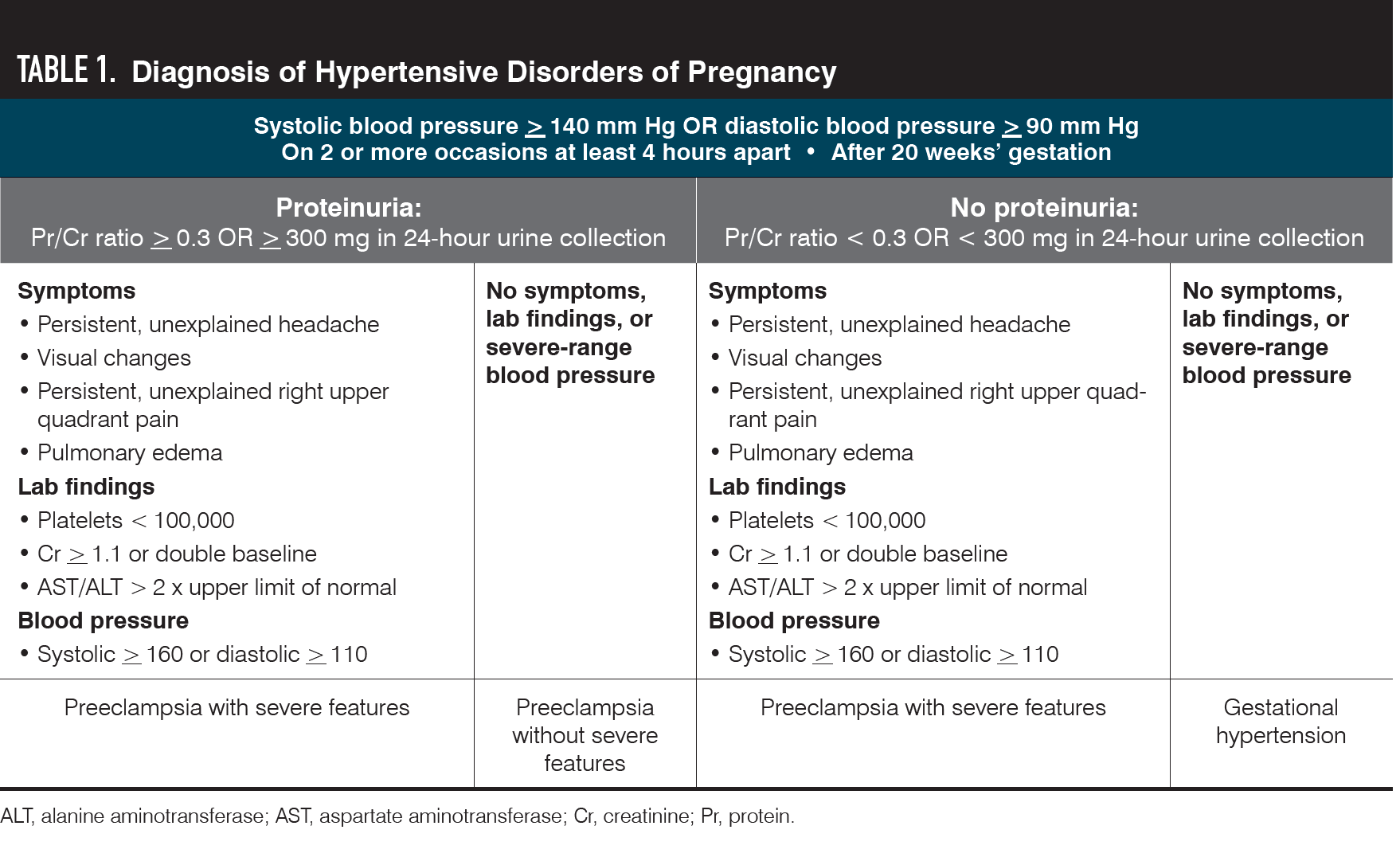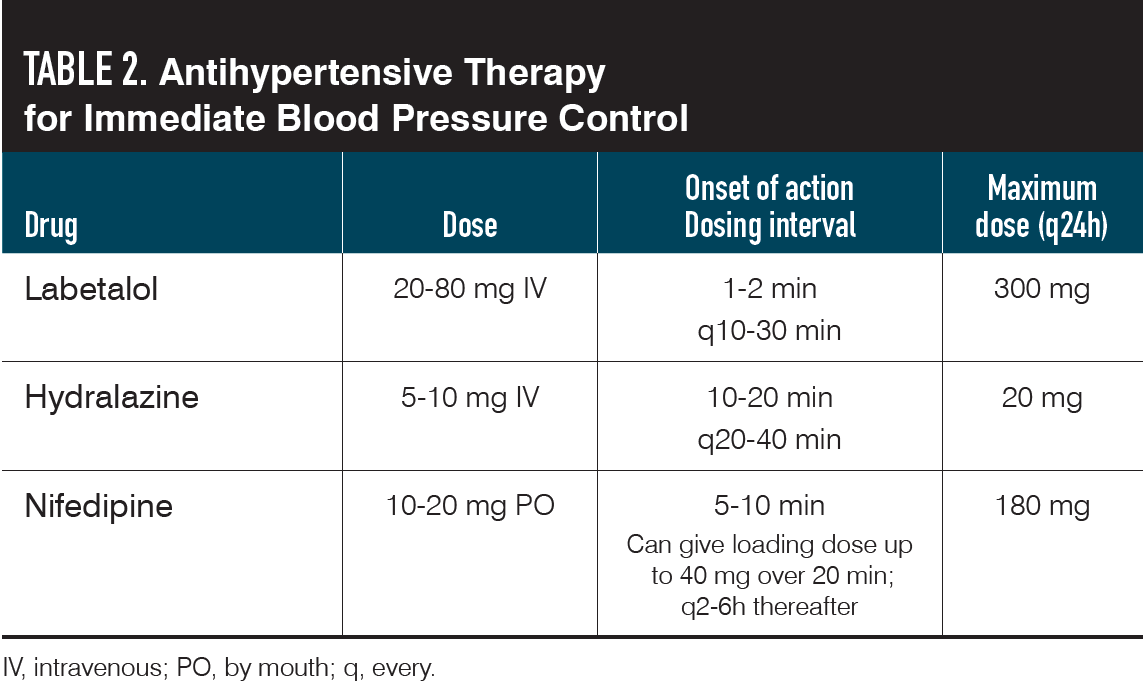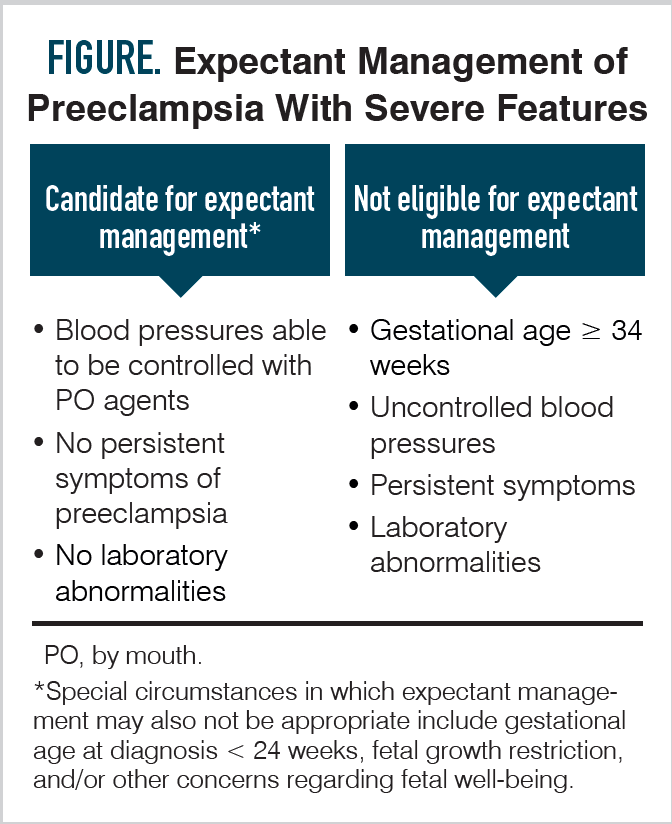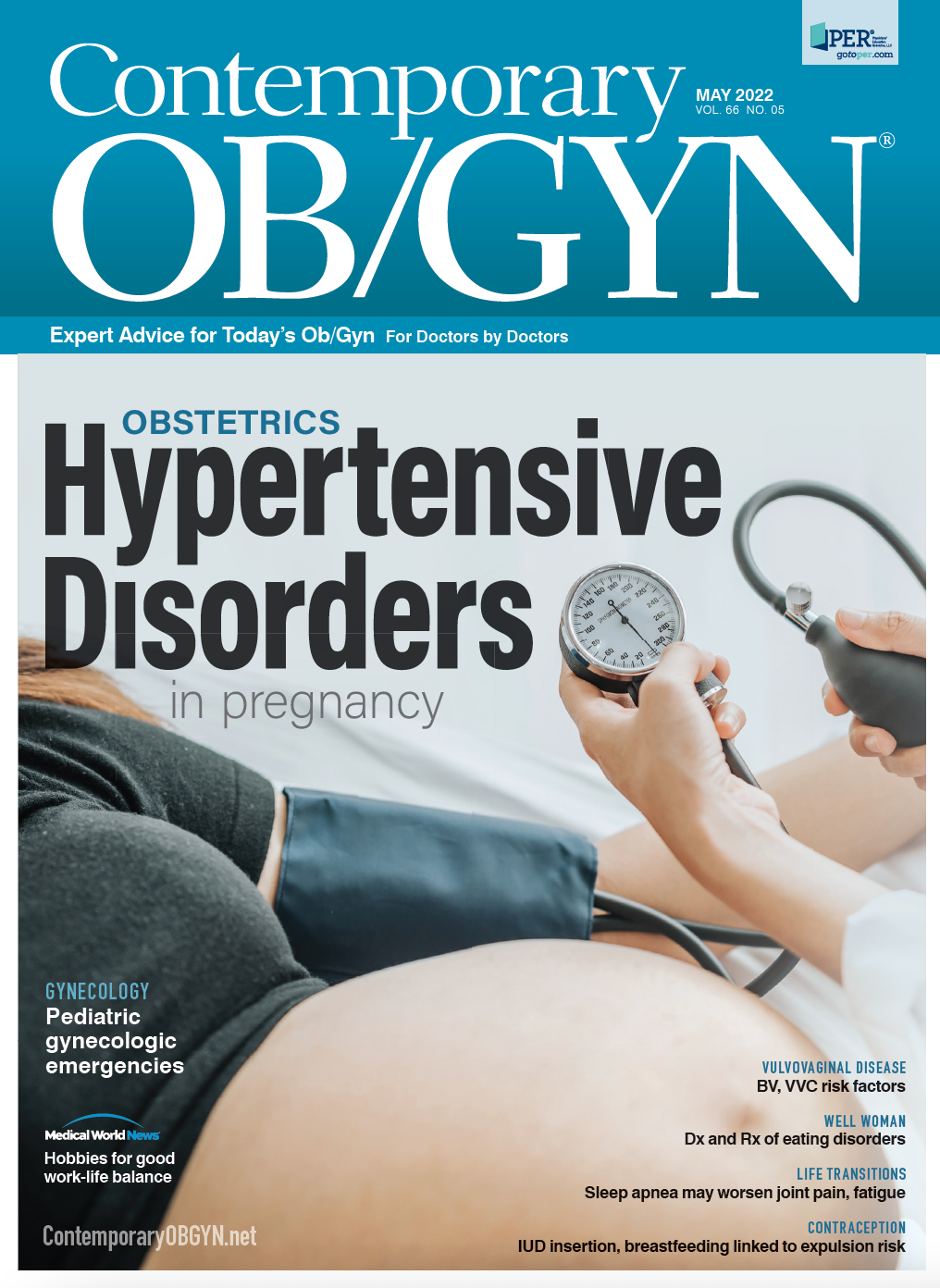Deep dive into hypertensive disorders in pregnancy
Diagnosis, management imperative for gestational hypertension and preeclampsia.
Nearly 10% of pregnancies are complicated by preeclampsia and related disorders,1 and preeclampsia accounts for approximately 16% of maternal deaths.2 Importantly, rates of preeclampsia are increasing, and this trend is expected to continue in part due to delayed childbearing and increasing obesity.3,4 Therefore, a baseline knowledge of preeclampsia diagnosis and management is of critical importance for the practicing obstetrician.
Diagnosis
Preeclampsia is one component of a group of disorders termed hypertensive disorders of pregnancy. At minimum, patients with hypertensive disorders of pregnancy must have systolic blood pressure of 140 mm Hg or greater or diastolic blood pressure of 90 mm Hg or greater on at least 2 occasions that are at least 4 hours apart after 20 weeks’ gestation.5 Additional evaluation is necessary to confirm the specific hypertensive diagnosis.
The initial work-up of someone suspected of having a hypertensive disorder of pregnancy should include a thorough history and physical examination. A reported history of hypertension in early pregnancy or prior to pregnancy can complicate the diagnosis and is addressed briefly at the conclusion of this article. The physical examination should focus on pulmonary auscultation; abdominal palpation; neurologic findings including deep tendon reflexes, visual fields, and/or clonus; and extremity assessment for peripheral edema.
A laboratory assessment for proteinuria should be undertaken using either the protein/creatinine ratio or 24-hour urine protein level. A complete blood count and creatinine and liver function testing are also recommended.
Table 1.

Utilizing the above information, the specific diagnosis can be established as seen in Table 1.5
Management
Gestational hypertension/preeclampsia without severe features
In general, patients meeting the criteria for 1 of these 2 conditions can be treated similarly. A diagnosis at or after 37 weeks of pregnancy should be treated with delivery.6 Blood pressure and the presence or absence of preeclampsia symptoms should be assessed regularly during the patient’s admission. A laboratory evaluation as described above should be completed on admission; additional laboratory evaluation is likely unnecessary in an asymptomatic patient with mild-range blood pressures.
If the diagnosis is made prior to 37 weeks of pregnancy, outpatient expectant management is appropriate and should include the following: weekly clinical assessment of blood pressure, physical symptoms, laboratory values, and fetal well-being. In the absence of progression to preeclampsia with severe features, it is safe to continue pregnancy until 37 weeks’ gestation.6
Preeclampsia with severe features
The management of preeclampsia with severe features can be less clear depending upon the clinical criteria utilized to make the diagnosis and the gestational age at which the diagnosis is made.
At term (> 37 weeks’ gestation)
Preeclampsia with severe features at term is an indication for delivery. The diagnosis alone is not an indication for cesarean section, although cesarean delivery may be indicated in patients with disease progression or worsening during labor.
Table 2.

Regular blood pressure assessment is recommended. Systolic blood pressure of 160 mm Hg or greater or diastolic blood pressure of 110 mm Hg or greater should be treated to prevent maternal stroke. Commonly used antihypertensive agents including their dosing, interval, and maximum cumulative dose are shown in Table 2.
Magnesium sulfate should be administered for seizure prophylaxis. Its use halves the risk of eclampsia and has also been associated with a reduced risk of placental abruption and maternal mortality.7,8 In patients with normal renal function, a loading dose of 6 g over 30 minutes followed by a maintenance dose of 2 g/hr is recommended. Administration should continue throughout labor and for 24 hours after delivery is achieved. During this time, it is critical to monitor for symptoms of magnesium toxicity which can include decreased deep tendon reflexes and respiratory depression followed by cardiac arrest. Although a goal therapeutic range is quoted of 4.8-9.6 mg/dL, routine monitoring of magnesium levels is probably unnecessary in patients with normal exams and normal kidney function.9
In addition to monitoring for symptoms of magnesium toxicity as described above, clinicians should frequently assess patients for the development of symptomatic preeclampsia, including shortness of breath, headache, visual disturbances, and right upper quadrant pain. Regular physical examination of the lungs, abdomen, and deep tendon reflexes is warranted. The need for serial laboratory assessment to monitor for worsening preeclampsia is not well established. Clinicians may consider repeating laboratory examination in patients with blood pressure that is difficult to control, persistent symptoms, new physical examination findings, or oliguria.
Late preterm
(> 34 weeks’ gestation)
Preeclampsia with severe features is also an indication for delivery in the late preterm period. The risks of prematurity at this gestational age are outweighed by the maternal risks associated with preeclampsia progression including pulmonary edema, myocardial infarction, stroke, acute respiratory distress syndrome, renal failure, liver failure, and coagulopathy. Delivery should not be delayed for the administration of late preterm steroids for fetal lung maturity.5
Preterm (24-33 weeks’ gestation)
The clinical treatment of patients with a preeclampsia diagnosis with severe features in the early preterm period is dependent upon the diagnostic features present. The option for expectant management is predicated on the balance of maternal and neonatal risks from potential disease progression and the known neonatal risks of prematurity.
Figure

Patients meeting the criteria listed in the Figure can be considered for inpatient expectant treatment.10,11 Among patients undergoing expectant treatment, the regular assessment of symptoms, blood pressures, laboratory values, and fetal well-being and growth is crucial. Delivery is recommended in this group of patients in the event of persistent severe-range blood pressures, new symptomatic findings, abnormal laboratory values, or concerns regarding fetal well-being, or at 34 weeks’ gestation. Although fetal growth restriction is no longer considered a contraindication to expectant management, clinicians should consider increasing the frequency of fetal monitoring and fetal growth assessments with, perhaps, lower thresholds for delivery in this subgroup of patients than those with normal fetal growth.5
Steroids for fetal lung maturity should be administered upon admission regardless of a patient’s candidacy for expectant management. Consultation with the pediatrics and/or neonatology department is also recommended to review expected neonatal resuscitation and complications of prematurity.
When delivery is recommended in patients with preterm preeclampsia with severe features, induction of labor is typically preferred. The likelihood of successful induction is dependent upon gestational age and parity with patients at earlier gestational ages being less likely to achieve vaginal delivery. The decision for outright cesarean delivery should be made after discussion with the patient and include consideration of their future reproductive wishes and clinical stability in addition to gestational age and parity.
Recommendations for magnesium prophylaxis, blood pressure control, and frequent assessment are the same as those discussed above for term patients.
Hemolysis, Elevated Liver Enzymes, and Low Platelet Count (HELLP) Syndrome
Patients with HELLP syndrome comprise a special subgroup of patients with preeclampsia with severe features. Diagnostic features of HELLP syndrome include hemolytic anemia (lactate dehydrogenase, > 600 U/L), thrombocytopenia (< 100,000), and elevated liver function testing greater than 2 times the upper limit of normal.5
Patients with HELLP syndrome are not candidates for expectant treatment regardless of gestational age at presentation. Efforts to affect delivery should be undertaken shortly after diagnosis. Steroids for fetal lung maturity can be administered to preterm patients but should not delay delivery.
As with all hypertensive disorders of pregnancy, HELLP syndrome alone is not an indication for cesarean section. Clinical factors to consider when determining the mode of delivery should include patient parity and gestational age, current laboratory values and the stability of those abnormalities, blood product availability, anesthesia availability, fetal well-being, and patient preference.
Serial laboratory examination in patients with HELLP syndrome, including assessment for maternal coagulopathy, should occur at least every 12 hours. Patients with HELLP syndrome should have 2 peripheral intravenous lines. The blood bank should be apprised of the patient’s clinical scenario, and appropriate blood products prepared for the event of clinically significant bleeding and/or coagulopathy.
The remainder of their clinical management is the same as described above.
Eclampsia
Initial treatment of patients with eclampsia should be directed to basic life support, including mobilization of an emergency response team, prevention of maternal injury or aspiration, positioning in left lateral decubitus posture, and monitoring of maternal vital signs. Magnesium sulfate can be administered intravenously in the dosage described above. Alternatively, intramuscular dosing of 5 g in each gluteal muscle (total, 10 mg) can be utilized if intravenous access has not yet been obtained.
After the initial stabilization described above, an assessment of fetal status is warranted. Attempting to assess fetal status during an eclamptic seizure is not recommended.
Patients with eclampsia are not candidates for expectant treatment regardless of gestational age at presentation. As with HELLP syndrome, efforts to achieve delivery should be swiftly undertaken and not delayed for the administration of steroids. Mode of delivery considerations are similar to those described for HELLP syndrome.
Head imaging is not necessary for classic presentations of eclampsia but should be considered in patients with recurrent seizures after the administration of magnesium.
History of Chronic Hypertension
Due to the decreased systemic vascular resistance seen in pregnancy, blood pressure typically decreases in the late first and second trimesters. After that time, an increase in baseline blood pressure values may be seen. This expected increase in blood pressure in the late second and third trimester may be difficult to differentiate from superimposed preeclampsia in patients with a history of chronic hypertension.
The first step in making this diagnosis should include a thorough history and physical exam as described above. An examination of medical records for blood pressure trends outside of and in early pregnancy may also prove helpful as patients who have exceeded their previously recorded values are more likely to be experiencing preeclampsia. Laboratory examination of liver function and hemoglobin, platelet, creatinine, and proteinuria levels is also warranted. A comparison of these values to early or prepregnancy levels may prove helpful in making the correct diagnosis.12
Although patients can undergo this diagnostic workup as an outpatient, providers should have a low threshold to complete the workup as an inpatient evaluation. Inpatient evaluation is recommended for patients with severe-range blood pressures, possible symptoms of preeclampsia, or abnormal laboratory findings. Patients for whom these findings are persistent likely have superimposed preeclampsia and should be treated according to their gestational age as described above.
In a patient with no symptoms, mild-range blood pressures, and normal laboratory testing, continued close outpatient monitoring is appropriate. Tenets of outpatient monitoring include frequent ambulatory and/or home blood pressure checks, patient education on preeclampsia symptoms, and regular assessment of fetal growth and well-being.
Postpartum Care and Implications for Future Health
Although hypertensive disorders of pregnancy are typically considered “cured” after delivery of the fetus, ongoing considerations for patient health exist in the immediate postpartum period and beyond.
Blood pressure readings can continue to increase in the immediate postpartum period secondary to interstitial fluid mobilization and return to the intravascular space. To decrease the risk of maternal stroke from unrecognized and/or untreated severe-range blood pressures, an evaluation of blood pressure is recommended no later than 10 days post partum.5,13,14 Consensus on best timing for this evaluation has not been reached. Providers should consider disease severity when scheduling this follow-up.
In-person or at-home blood pressure assessment can be considered.13, 15
Lastly, patients should be educated on their increased risk for future cardiovascular disease, stroke, and peripheral artery disease. Patients affected by hypertensive disorders of pregnancy are at least 2 times more likely to experience these complications later in life.16-18 Patients with more severe disease are at an even greater risk.19 Obstetric providers should arrange for or confirm primary care follow-up for cardiovascular risk factor screening and counseling on risk reduction.
Conclusion
New blood pressure elevation after 20 weeks’ gestation is concerning for hypertensive disorders of pregnancy and should be promptly evaluated and treated to avoid associated maternal, fetal, and neonatal morbidity or mortality. Obstetric care providers are in a unique position to influence long-term maternal health by educating patients on the long-term risks associated with this condition and ensure ongoing primary care follow-up.
References
- Steegers EAP, von Dadelszen P, Duvekot JJ, Pijnenborg R. Pre-eclampsia. Lancet. 2010;376(9741):631-644. doi:10.1016/S0140-6736(10)60279-6
- Khan KS, Wojdyla D, Say L, Gülmezoglu AM, Van Look PF. WHO analysis of causes of maternal death: a systematic review. Lancet. 2006;367(9516):1066-1074. doi:10.1016/S0140-6736(06)68397-9
- Wallis AB, Saftlas AF, Hsia J, Atrash HK. Secular trends in the rates of preeclampsia, eclampsia, and gestational hypertension, United States, 1987-2004. Am J Hypertens. 2008;21(5):521-526. doi:10.1038/ajh.2008.20
- Ananth CV, Keyes KM, Wapner RJ. Pre-eclampsia rates in the United States, 1980-2010: age-period-cohort analysis. BMJ. 2013;347:f6564. doi:10.1136/bmj.f6564
- ACOG Practice Bulletin No. 202: gestational hypertension and preeclampsia. Obstet Gynecol. 2019;133(1):1 doi:10.1097/AOG.0000000000003018
- Sibai BM. Management of late preterm and early-term pregnancies complicated by mild gestational hypertension/pre-eclampsia. Semin Perinatol. 2011;35(5):292-296. doi:10.1053/j.semperi.2011.05.010
- Altman D, Carroli G, Duley L, et al; Magpie Trial Collaboration Group. Do women with pre-eclampsia, and their babies, benefit from magnesium sulphate? The Magpie Trial: a randomised placebo-controlled trial. Lancet. 2002;359(9321):1877-1890. doi:10.1016/s0140-6736(02)08778-0
- Duley L, Gülmezoglu AM, Henderson-Smart DJ, Chou D. Magnesium sulphate and other anticonvulsants for women with pre-eclampsia. Cochrane Database Syst Rev. 2010;2010(11):CD000025. doi:10.1002/14651858.CD000025.pub2
- Okusanya BO, Oladapo OT, Long Q, et al. Clinical pharmacokinetic properties of magnesium sulphate in women with pre-eclampsia and eclampsia. BJOG. 2016;123(3):356-366. doi:10.1111/1471-0528.13753
- Odendaal HJ, Pattinson RC, Bam R, Grove D, Kotze TJ. Aggressive or expectant management for patients with severe preeclampsia between 28-34 weeks’ gestation: a randomized controlled trial. Obstet Gynecol. 1990;76(6):1070-1075.
- Sibai BM, Mercer BM, Schiff E, Friedman SA. Aggressive versus expectant management of severe preeclampsia at 28 to 32 weeks’ gestation: a randomized controlled trial. Am J Obstet Gynecol. 1994;171(3):818-822. doi:10.1016/0002-9378(94)90104-x
- Morton A, Burke M, Jarvis E, Kumar S. Changes in proteinuria and diagnosing preeclampsia in CKD pregnancy. Pregnancy Hypertens. 2020;20:92-95. doi:10.1016/j.preghy.2020.03.005
- ACOG Committee Opinion No. 736: optimizing postpartum care. 2018;131(5):e140-e150. doi:10.1097/AOG.0000000000002633
- Too G, Wen T, Boehme AK, et al. Timing and risk factors of postpartum stroke.Obstet Gynecol. 2018;131(1):70-78 doi:10.1097/AOG.0000000000002372
- Hirshberg A, Bittle MD, VanDerTuyn M, et al. Rapid-cycle innovation testing of text-based monitoring for management of postpartum hypertension. J Clin Outcomes Manag. 2017;24(2):77-85.
- Behrens I, Basit S, Melbye M, et al. Risk of post-pregnancy hypertension in women with a history of hypertensive disorders of pregnancy: nationwide cohort study. BMJ. 2017;358:j3078. doi:10.1136/bmj.j3078
- Stuart JJ, Tanz LJ, Missmer SA, et al. Hypertensive disorders of pregnancy and maternal cardiovascular disease risk factor development: an observational cohort study. Ann Intern Med. 2018;169(4):224-232. doi:10.7326/M17-2740
- Brown MC, Best KE, Pearce MS, Waugh J, Robson SC, Bell R. Cardiovascular disease risk in women with preeclampsia: systematic review and meta-analysis. Eur J Epidemiol. 2013;28(1):1-19. doi:10.1007/s10654-013-9762-6
- McDonald SD, Malinowski A, Zhou Q, Yusuf S, Devereaux PJ. Cardiovascular sequelae of preeclampsia/eclampsia: a systematic review and meta-analyses. Am Heart J. 2008;156(5):918-930. doi:10.1016/j.ahj.2008.06.042
Newsletter
Get the latest clinical updates, case studies, and expert commentary in obstetric and gynecologic care. Sign up now to stay informed.

